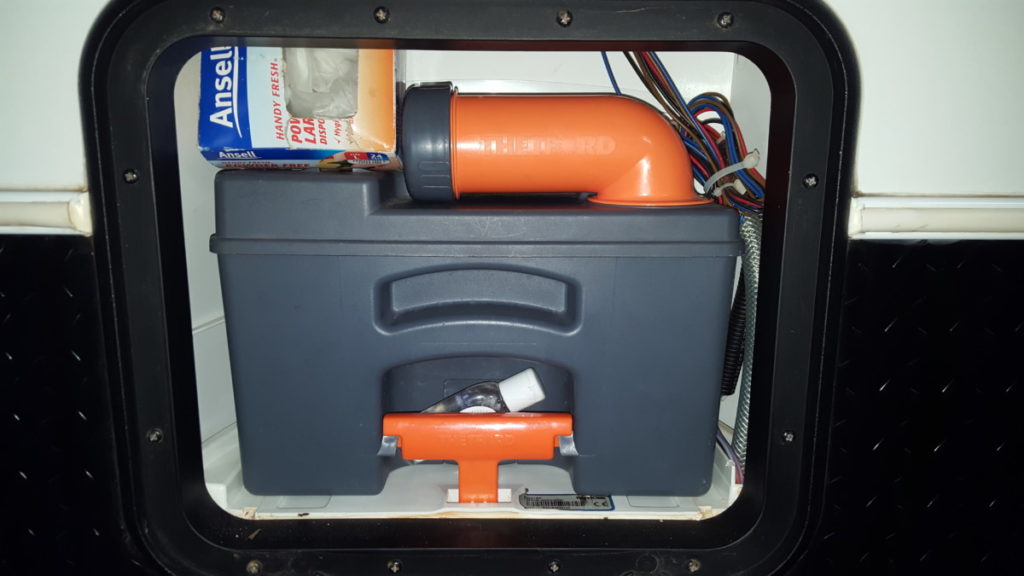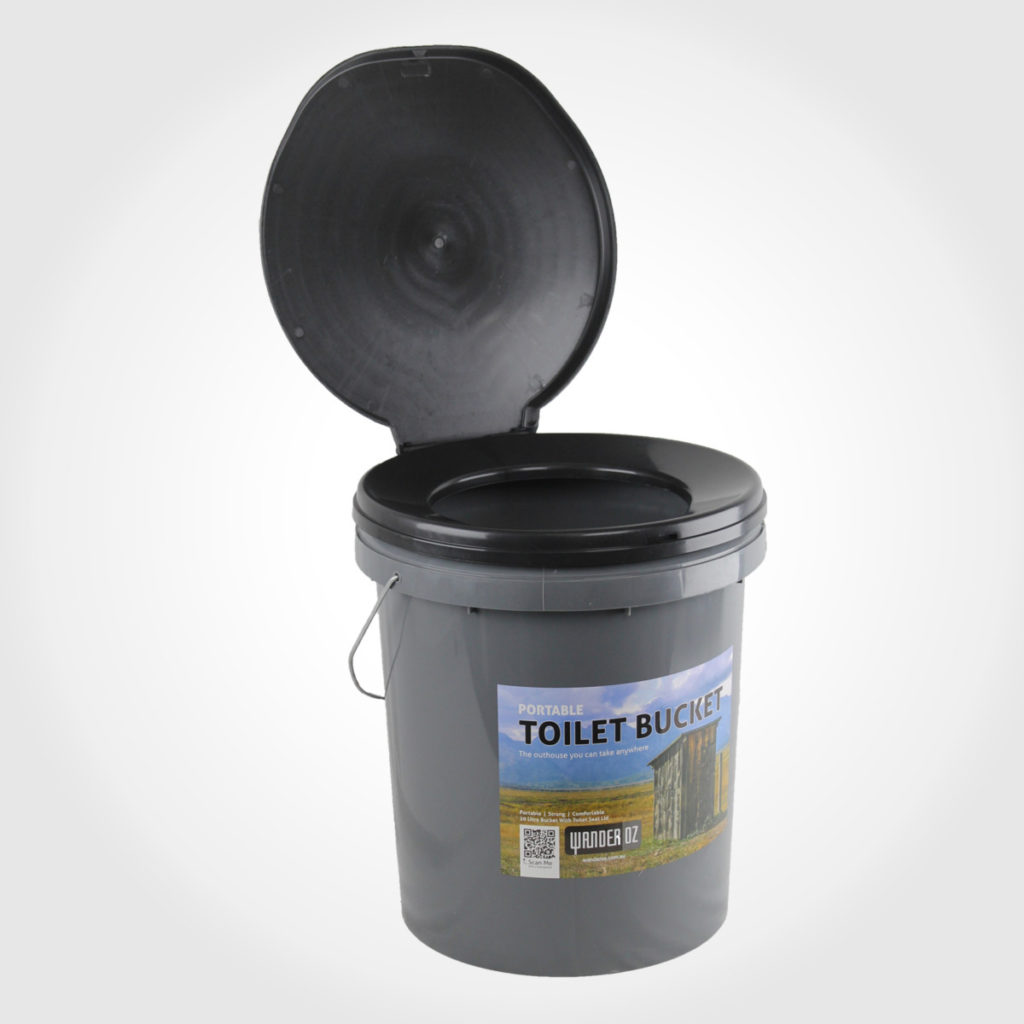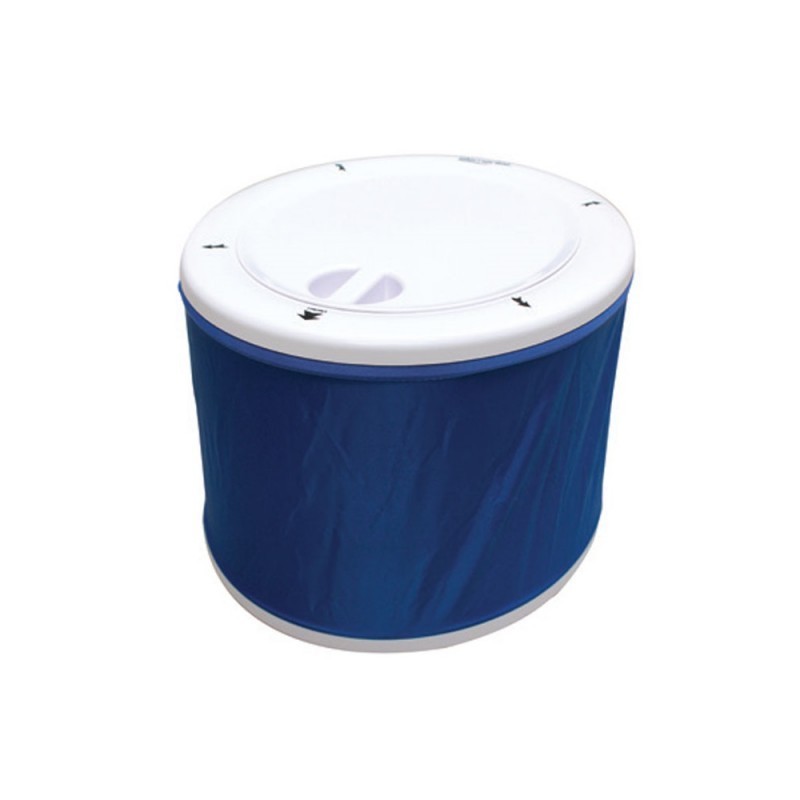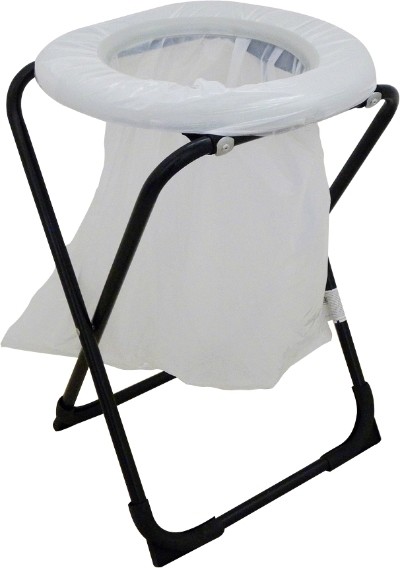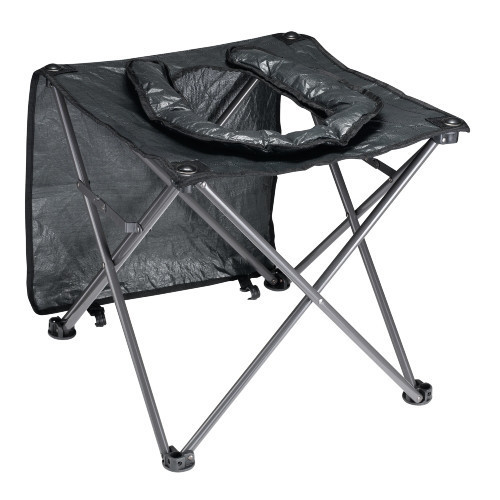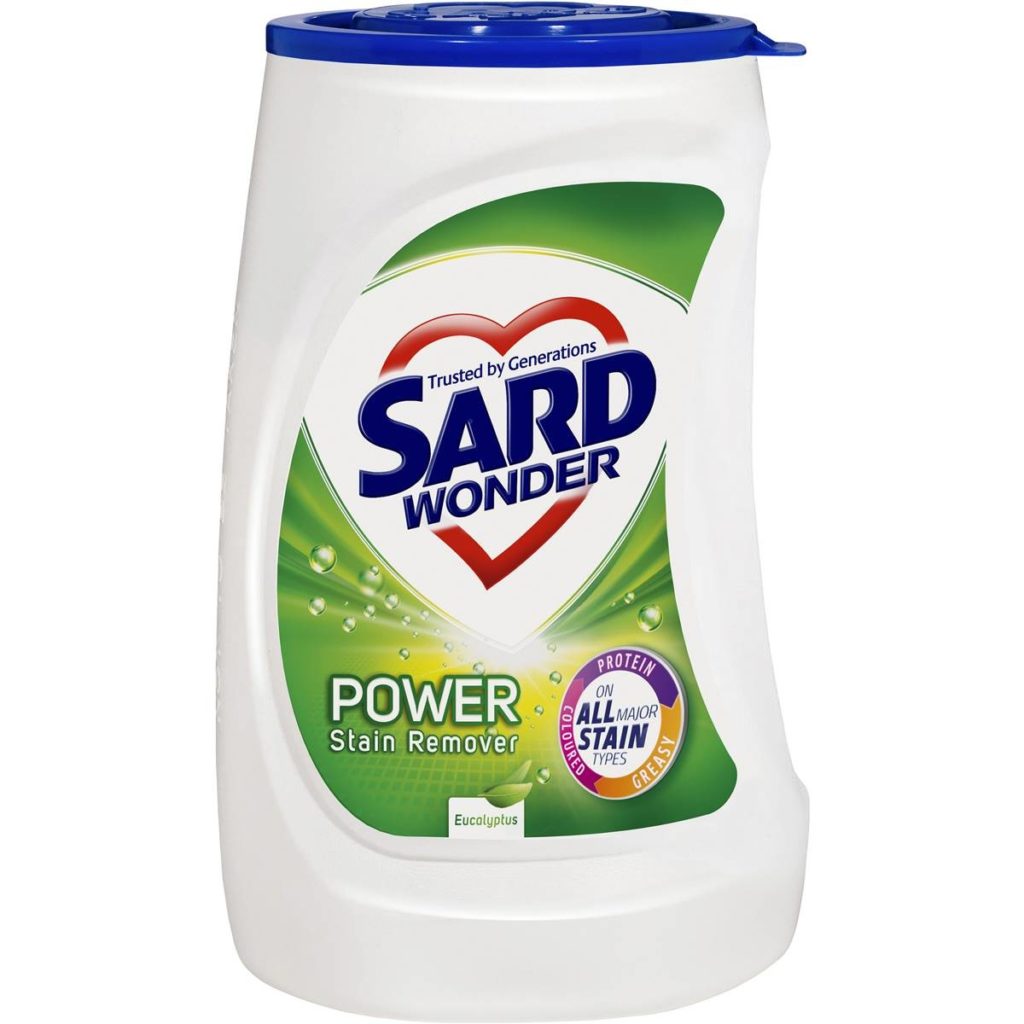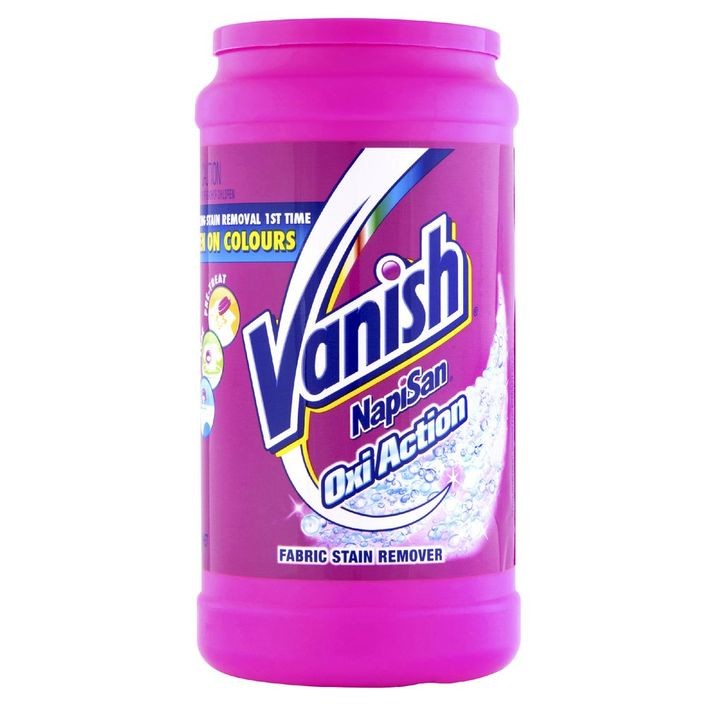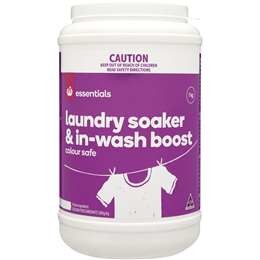Everything about pees and poos
Powdering your nose, spending a penny, call it what you like, we all need to go at some point and some methods are more appealing than others. Personally, I’m happy with a shovel and a roll of tickets.
Luckily when it comes to camping, there are plenty of toilet options available to us when the call of nature arises. From the trusty shovel to the composting onboard caravan units and everything in between, you’ll find something that suits your budget and requirements. Many caravans have a built in toilet onboard and those without will always have room to store a smaller model Porta Potti. Many camp areas and rest areas have toilets, some flushing and many long drops. Towns and facilities within towns such as sport ovals or boat rams etc often has public toilet facilities so you’ll rarely be too far away from a toilet.
I’ll start off with my take on the second earliest toilet ever invented, the shovel engineered hole in the ground. Following our simple proven method you should be able to join the ranks of the true Aussie Bushy, keep your dignity intact and hopefully not end up wearing any of it. A least 100mtrs from any water source, or other camper or camp areas in general, find a private spot and dig the hole at least a foot deep if not deeper. You’ll be wanting to squat in front of that hole and for very good reason not over the hole. Your exhaust has no aiming mechanism so don’t bother trying, you are unlikely to hit that target unless the hole is big enough to fall in, in which case you probably would. So forget about target acquisition, and concentrate on balance. If you find it incredibly difficult and beyond acrobatic to successfully squat without falling over, falling in or peeing on your own clothes. That’s because its bloody well near impossible but fear not because here is the kicker.
Drop your strides and underwear, leave one leg in and step one leg completely out. Pull them up and bunch them around your thigh where they’ll happily stay out of harms way for your entire performance. My arthritic knees are cactus and I manage fine; with my legs free its pretty easy to get this job done and if necessary I can steady myself on a tree, branch or the shovel. When your done use the shovel to completely cover and bury everything in the hole. Those who are a little more environmentally conscious can burn the paper if its safe to do so, or carry it back to camp in a bag for cremation or the bin.
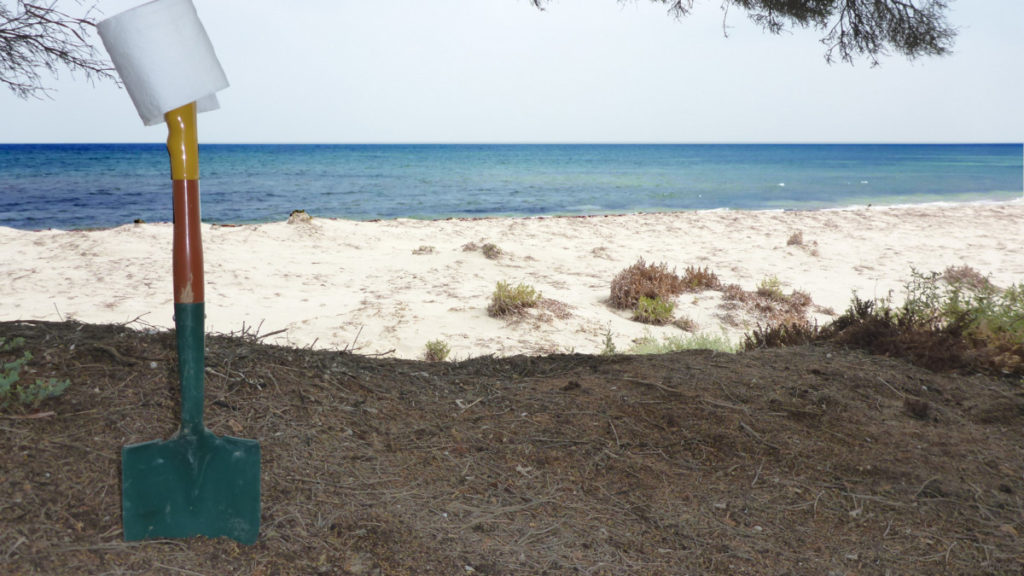
A tongue in cheek instructional video created after the repeated frustration of finding people (often backpackers) leaving a disgusting mess behind them when they leave
In the next toilet step up from the shovel there are a few very basic chair like toilets which use plastic bags, and some cheap bucket like toilets which use either chemicals or plastic bags. My opinion of these is simple, if it cant be sealed its not worth the risk of leakage in the car … urghhh, can you imagine that !!! We get holes in our grocery shopping bags all the time, and that’s bad enough.
The other more common and practical offerings are both the onboard van cassette toilets and the Porta Potti type sealed tank type toilets. With a caravan toilet your limited to what the manufacture provides. With the Porta Potti type toilet the range is vast with plenty of online Chinese imports around. Thetford branded Port Potti arent overly expensive anyway and in their favour a full range of parts are available in every caravan spare parts supplier. Thetford also have a very small compact unit, the model 145 which is only 330h x 383w and around $140. It’s very low to sit on and has only a 12ltr waste tank. We had one and for limited storage they’re terrific (oddly the flush tank is 3ltrs more than the waste tank … can’t work that one out)
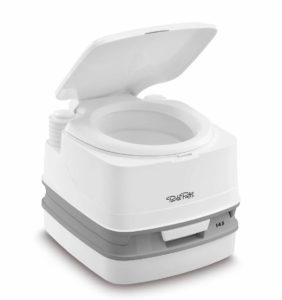
We have used all sorts of toilets over the years and one thing in common with all cassette type toilets is they require some kind of chemical or additive to reduce smells and assist in breaking down the contents over the short time they are captive in the tank. There are some fan systems that can replace the need for chemicals for a sort of air based composting process. The idea of untreated, sloppy human waste just sitting there composting genuinely disturbs me.
There are countless brands and types of chemicals and additives on offer, and they are all mostly expensive to very expensive. They all probably work, I say probably because I haven’t used commercial toilet chemicals since formaldehyde was all the rage 35 years ago. We’ve use Sodium Percarbonate in the form of nappy or laundry soaker in our caravan and portable toilets for many, many years. Nappy soaker or laundry soaker is the unbranded or no-name version of the identical product located higher on the supermarket shelves branded Vanish Napisan or Sard Wonder. You know the stuff that old school mums successfully used for a millennia in the big bucket full of shitty cloth baby nappies way back when. It worked extraordinarily well back then ….. and guess what, oddly it still works just as extraordinarily well now. Napisan is around $10 per kg and the more concentrated no-name version on the lower shelves is around $2.50.
Despite social media hype to the contrary, Sodium Percarbonate has not caused any adverse effects on any of our toilet components. Our previous toilet was 10 years in use and the current one 4 years.
The unsung hero that is the caravan toilet has a big horrible job to do, and deserves some requited love occasionally. Every couple of months or so and when we’re in a convenient location we completely dismantle the toilet cassette and get down and dirty with a good clean inside and out, along with regularly lubricating all the seals etc. Using a disposable glove and some olive oil, I run a film of oil around the rubber blade seals to lubricate and protect it.
The time effectiveness of toilet additives is limited to around 2 to 4 days, when the toilet should be emptied and urine is a far bigger issue in regards to smell than faeces. Urine left in the cassette too long will let you know with the rancid, very strong eye watering ammonia smell that it will give off. The active ingredients in the Sodium Percarbonate will remain active for around 6 hours. We use a single cap full at the first use and if we empty the cassette around the 2 day mark we have no horrendous smells. On the odd occasions where we’ve left it for 3 or 4 days we certainly knew we’d crossed that line, but that was mostly the urine.
If the toilet is only used for urine then nappy soaker is said to be less effective, so adding a table spoon of white vinegar will help to reduce any smell. The active ingredient in nappy soaker, Sodium Percarbonate oxygenates quite quickly with contact in water. Because Sodium Percarbonate is effective for only a short period it can be topped up with another cap full as required. Another regurgitated online furphy is sodium percarbonate should not be dumped in septic or long drops. Bacteria requires oxygen to thrive and Sodium percarbonate oxygenates in contact with water, so its quite fine for disposal in septic systems and pit toilets so long as the additive is at a normal concentration level.
The sodium percarbonate oxygenation process will be well and truly over when the cassette is emptied anyway, in which case you are adding nothing other than human waste and water to any septic or long drop.
Because sodium percarbonate activates with water, adding it to a fresh clean tank full of clean water will active the Sodium Carbonate and start the 6 hour hour active period. The way you use Sodium Percabonate as the toilet additive is very important. Our procedure is empty the cassette wash it out with dish washing detergent and then thoroughly rinse the cassette. Add a litre and a half of clean water to the cassette and return the cassette to the van. Only add the Sodium Percarbonte (down through the bowl into the cassette) at the first use of the toilet after cleaning, and this will ensure you get the appropriate 6 hour time benefit of the active ingredient.
My practical sodium percarbonate poo story. Years ago we owned a smaller off road van with no onboard bathroom facilities. We freecamped with a group of friends along the coast and the camp area had one of the best, cleanest, scent free long drops I’ve ever experienced. A week after that trip I had pre-arranged major shoulder reconstructive surgery and as a result of that and other commitments we didn’t camp again for over 10 months. Organising the van for it’s first soire after those long 10 months, I was astonished to find I’d left water in the top tank of the Porta Potti – something I never did. Despite the long drop of the last camp, for some reason Barb could no longer recall, she had set up the Porta Potti for our youngest son to use and slid it back into the cabinet where it was stored. She promptly forgot about it and there it sat stewing for the next 10 months including half a summer. To put that into perspective, if disproportionate giant toxic poo’ing was an Olympic sport our son Daniel would be a coach at the Australian Institute of Sport. I was terrified at what I would be confronted with, but there simply was no graphic horror story to be made out of this. And that’s why we continue to use sodium percarbonate, we’ve proven it’s the best. (thank god it was the best)
A couple of articles in relation to sodium percarbonate, it’s use in caravan toilet cassettes and also its effects on septic systems and long drops.
First article is authored by Chemistry Professor Ian Jenkins from Griffith University in QLD
Second article said to be authored by an Industrial Chemist, although the author is un-named
So ….. unless the naysayers are a higher authority than a Chemistry Professor or annonymous Industrial Chemist I’m happy to continue to roll with my $2.50 laundry soaker. (I wasnt about to change anyway)
Toilet cassette
The Walk of Shame is the term of endearment I refer to in toting the cassette to the caravan park dump point. On week block change over day during the Xmas holidays it’s like a conga line of sad people being sent to their deaths. Like everything we do we have a procedure for dumping the cassette as well. Before I even open the dump point lid I remove both the pour out spout cap, the sliding seal cover and leave both on the ground adjacent to the dump point. There is probably over a hundred caps bobbing about in every dump point across Australia. That will never happen to me because not only are they around $30 I would guarantee that should mine go down the dump pipe I’d be 1000km from the nearest parts supplier.
There a variety of dump point designs in use but the Gough Plastics blue lid Dump Ezy is increasingly becoming the norm. One caravan park in Ballarat has a 1940’s single timber outhouse with a normal flushing toilet inside as the dump point and there are many older open formed concrete ones.
I always wash around the dump point with the dump point hose before and after my visit for the benefit of myself and everyone after me. Before using the dump point wet all the surfaces to help “prime” the system and provide a bit of glide and wash away anything the last person left behind. After using the dump point I rinse it again thoroughly to well and truly flush away all evidence of my activities.
Most cassettes will have a couple of obvious places to hold it for emptying, and somewhere at the rear where you hold it at the opposite end to the pour out spout will be a coloured air release button. The trick is in one smooth arching action point the pour out spout at the dump point hole, and push the air release at the same time. The air release will allow air to rapidly enter the cassette to assist the rapid dumping of the contents avoid a kind of glug, glug, glug empty and serious risk of poo water splash-back … (just saying that makes you feel like washing your hands). On this Thetford C260 cassette (and most other cassettes are similar) the small orange button on the very top right is the air release which is positioned where your thumb sits.
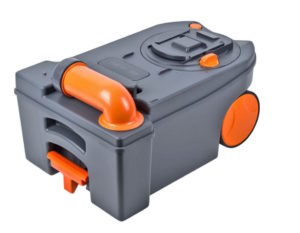
One thing you will no doubt discover for yourself anyway is the little bit of water that sits hidden under the sliding seal cover that will run over your hand during the emptying of the cassette right at that point where you’ve committed, that point of no return. The fact it’s just flush water and not actual poo water never seems to make an ounce of difference … it’s close enough to poo water, so it’s totally gross anyway. To make it worse you have to let it run all over your hand because you can’t jeopardise your smooth arching emptying action and risk the dreaded glug, glug, glug and the accompanying poo water splashback.
After someone uses the toilet and closes the cassette blade a little too soon, the remnants of the flushing water dribbles down the bowl and accumulates on the cassette blade, generally dropping harmlessly into the cassette when the next person opens the blade to use the toilet. On the last use the water just sits there like an assassin and when the cassette is removed for emptying the sliding seal cover conceals this water, which waits patiently until you tip the cassette up to empty it and the water then runs out over your hand. If you remove the sliding seal cover like i do, you should see that water. On the top of the cassette is also a coloured lever which opens the cassette blade; and opening and closing the blade will let the water drop away safely into the cassette … and not over your hand later. A good rule is to leave the cassette blade open after flushing for 10 seconds, or about the time it takes to get dressed, hands washed and ready to walk away.
In this pic the sliding seal cover has be manually slid back halfway to expose the seal and blade underneath. The orange knob below the cover opens the blade both manually with the cassette removed and when the cassette is in the van. The handle on the toilet itself which opens the blade to use the toilet connects to this knob. The slide cover is just an aesthetic feature to conceal that nasty poo hole and like curtains at the cinema, it performs no real practical purpose. The cover automatically slides back and away when the cassette is inserted into the van and slides forward when the cassette is removed. It slides in only one direction, fits only one way and there is no resistance to sliding it back and out by hand. You should note that the cover slides in the direction of the pour spout meaning a loose cover knocked out, or which slides out during emptying of the cassette will fall in the direction of the dump point hole. This is why i remove the sliding cover.
If you do unfortunately loose the cover the toilet will function perfectly well without it.
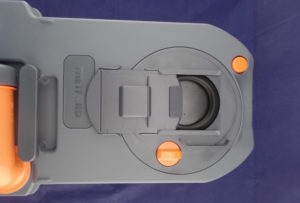
After dumping, half fill the cassette and lightly shake the water about to rinse. Half fill again with a small amount of sink detergent, lightly shake empty and then rinse the soap out. Looking through the open blade put enough freshwater to cover the plastic
With a scented top tank rinse aid we make up a spray bottle and spray into the bowl after use; after flushing with a big job, and in lieu of flushing for a squirt. That adds a nice perfumed smell to the toilet.
Poo tickets (paper)
The large multinational companies that manufacture the expensive caravan toilets would like us to believe that their own expensive branded toilet paper is paramount to the performance of the cassette toilet. Nothing could be further from the truth. This conspiracy inspired creation of doubt spurred along by the accessory industry has reaped large profits for all involved based on deception and fresh air. Most parts or accessories with “caravan” in the description are ridiculously overpriced anyway and we don’t need to be coerced into buying substandard toilet paper at insultingly inflated prices.
Any parts accessory provider that supports and perpetuates this rubbish for their own greedy ends really doesn’t deserve your business. Any septic safe toilet paper is equal to if not a better option. We use Kleenex or Quilton brands based on nothing more than which is on special. Have a look at both these videos, and make up your own mind armed with genuine unbiased advice.
The external toilet tank area behind the hatch has some small nooks perfect for leaving a tube of hand sanitiser, and a box of disposable gloves exactly where they will be needed. When we empty the tank in transit, having that hand sanitiser at the cassette is terrific.
